13.5: Implementing social media advertising
- Page ID
- 24939
Each platform has its own objectives, ad types, and targeting options. In this section, we will examine a few of the most popular ones.
We have already looked at what kind of audience can be found on Facebook and the broad strokes of what they offer.
Objectives
Facebook offers several paid-for advertising solutions based on the action the advertiser wants the audience to take, the purpose of the ads. The core objectives are awareness, consideration, or conversions, which Facebook has broken down further into more specific objectives on which you can base your ad creation.
- Awareness
- Brand awareness
- Local awareness (promoting to users nearby)
- Reach (show your ad to the maximum possible number of users).
- Consideration
- Traffic (sending users to your website or app)
- App installs
- Engagement (encourage comments, page likes, shares, event responses, and offer claims)
- Video views
- Lead generation (collect lead information from interested parties).
- Conversion
- Conversions (encourage valuable actions on your website or app)
- Product catalogue sales (create ads that automatically show products from your catalogue based on your target audience)
- Store visits (promote multiple business locations to users nearby) (Facebook, 2017).
The ad format you choose will match your advertising objective.
Ad types
Once you have chosen an objective, Facebook offers a set number of ad formats to choose from that will help you meet that objective. Those formats are:
- Single image
- Single Video
- Carousel
- Slideshow (video-like ads)
- Dynamic ads
- Lead ads
- Boosted posts and promoted posts
- Collection
- Messenger ads
- Canvas (an ad type that offers different components in various configurations to tell a brand story).


These ads have several options for placement in your users’ feed. They can appear RHS (right hand side) desktop, in the news feed on desktop, or in the news feed on mobile. Because Facebook owns Instagram, you also have the option of showing certain ad types there. The vast majority of Facebook’s revenue comes from mobile, so they are very focused on a good mobile experience for their users. Find out more about their ads here: https://www.facebook.com/business/ads-guide You can also find a very useful infographic summarising the various options here: wersm.com/the-complete-guide-to-facebook-ad-specs/#prettyPhoto/0/.
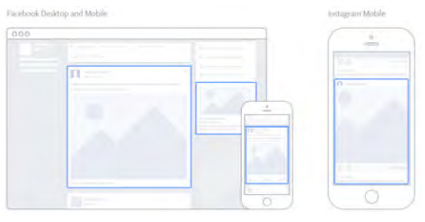
Targeting options
Once you have chosen an objective and ad type, you will need to look at Facebook’s targeting options, which gathers user data from Instagram and WhatsApp as well. They offer three audience options to choose from:
Facebook advertising information can be found at: www.facebook.com/ business/products/ads.
- Core audiences, where you select your audience manually based on demographics like age and location.
- Custom audiences, where you upload a contact list to connect with customers on Facebook.
- Lookalike audiences, where you use customer information to find people similar to them on Facebook.


Core audience (manual) selection allows many detailed targeting options:
- Location: Where the users are located, city, region etc. Allows exclusion of locations.
- Demographics: Age, gender, languages, relationships status, type of work, education, and more.
- Interests: Interests, hobbies, and Pages they like on Facebook.
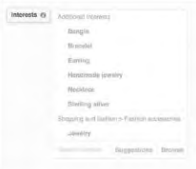
- Behaviours: Activities users do on or off Facebook that give information on which device they use, their purchase behaviours or intent, travel preferences, and more.
- Detailed targeting: Offers the option to include or exclude users who meet at least one parameter (not all of them). This can include whether people have a connection to you on Facebook (or have friends who do).
For a full list of Facebook targeting options, look at this infographic: i.marketingprofs. com/assets/images/daily-chirp/170213-infographic-complete-guide-to-facebookad-targeting-full.jpg
If you select multiple options from within an ad targeting category, you’ll reach users who meet any of the options you’ve selected. For example, if you choose multiple Locations like the United States and Canada, you’ll target anyone who lives in either the United States OR Canada, not both.
Another example might be choosing multiple options from the Interests targeting category. If you choose interests like Golf and Tennis, you’ll target anyone who likes golf OR tennis, not just users who like both golf and tennis. Keep in mind that it’s not possible to target ad sets only to the users who fall into all of the selected categories. Custom audience selection has several benefits, including:
- Powerful exact targeting
- No wastage
- Cap bidding and frequency
- Data is encrypted and secure.
Using these selectors, you can create a list of who you want to reach using their email addresses. Facebook matches the email addresses and allows exact targeting of those users through their ads. Custom audiences are extremely powerful; if you have users’ email addresses, you can target individuals. This is useful for any brand that uses newsletters or gathers email addresses elsewhere.
Lookalike Audiences is useful because it helps you find a similar audience to your existing fans and gives more accurate targeting. This makes it easy to find more users on Facebook who are like the people you know. You can build a Lookalike Audience based on:
- People who like your Page
- Custom Audiences that you’ve created with emails, phone numbers, or website or app data.
It’s an effective way to reach even more potential customers because you can target your Lookalike Audience with the adverts you create.
The Facebook Pixel
The Pixel is a piece of code you can build into your website to help you track user actions and remarket to them on Facebook. Your conversions can be tracked across mobile phones, tablets and desktops, you can optimise your bids for website conversions and ensure that your ads will be shown only to the users most likely to convert, and you can remarket to or reach users on Facebook who have visited your website. You can learn more about the pixel and get started with it here: www.facebook.com/business/a/facebook-pixel.
Facebook advertising tips
As you dip your toes into Facebook advertising, remember:
- Ads can be unpublished posts targeted at a specific audience.
- Multiple ads can run at the same time.
- Targeting should not be too granular, unless the audience is highly qualified.
- With awareness-based advertising, keep your reach and frequency as high as possible.
- Check your ads in Facebook’s Ads Manager (or, for more advanced advertisers with multiple campaigns and ad sets, the Power Editor).
Facebook will suggest a bid to help make sure that your ad will reach a significant portion of your audience.
Instagram is a very large mobile platform with an engaged mobile audience, making it a good option for some businesses.
You can do Facebook’s own training course, Facebook Blueprint, for free to learn every aspect of its offering: www.facebook. com/blueprint
Objectives
Instagram offers three ad types driven by the objectives you want to achieve, which are not surprisingly, similar to Facebook ad objectives:
- Brand awareness
- Reach
- Traffic
- App installs
- Engagement
- Video views
- Lead generation
- Conversions
Ad types offered
Not every ad type is available for every objective. Once you choose an objective, you will be shown the ad types you can use. The three ad types offered by Instagram are:
- Single image ads, which are exactly what they sound like.
- Video ads, which can share videos up to 60 seconds long.
- Carousel ads, which are similar to single image ads but include multiple images that users can swipe to see.
- Slideshow ads, which are like Carousel ads, except the images scroll on their own with music creating a mini video.
- Instagram Stories Ads, which include single image and single video ad formats that are placed within Instagram Stories (ShorterURLs, 2017).
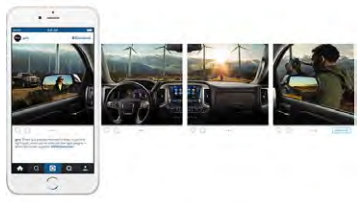
Some companies can expand the types of Twitter advertising available, For example, Ad Dynamo (www.addynamo.com/new), which is focused on Africa, offers a range of ad types that are not available through self-service. Blue Robot (www.bluerobot. com/index.jsp#about) is another company that allows you to automate Twitter in a number of ways, such as automatically responding to Tweets with live data or building automated responses based on Tweets from various locations.
Targeting options
Instagram has many of the same targeting options as Facebook. They include:
- Custom audiences (target audiences of users you already know, which includes lookalike audiences)
- Location, age, gender, language targeting
- Detailed targeting (include or exclude users based on demographics, interests and/or behaviours)
- Connections (include or exclude users based on connections to your page, apps, or events).
You can also save an audience to use it for future ad sets.
Instagram advertising tips
- Remember, Instagram shares targeting options with Facebook so make use of them, but don’t go too granular.
- Don’t make your post look like an ad, it should be visually arresting and enjoyable first, advertising second. It should blend in with organic content rather than stand out as an ad.
- Include a hashtag so that users can find your posts/ads more easily. Bigger brands can create their own hashtags.
You can find out more about advertising on Instagram at: https:// business.instagram. com/advertising or at blog. hootsuite.com/howto-use-instagram-forbusiness/
- Try to tell a brand story and think carefully about how details will affect what audiences take from your images.
Twitter offers a self-service ad platform with several options and allows a degree of specific targeting. The service does still tend to change frequently, and not all options may be available to all regions or user accounts. Objectives Like Facebook, this is mobile first and the ad formats match the actions you want users to take. The basic objectives are:
- Promote your brand
- Website clicks or conversions
- Increase followers
- Awareness
- Tweet engagements
- Promote your video
- Video views
- Drive conversions
- App installs or re-engagements.
Learn more about Twitter campaign types (which are slightly different from ad objectives) here: business.twitter.com/en/advertising/campaign-types.html
Ad types offered
- Plain text tweet are tweets that appear at the very top of a user’s timeline, or in Twitter mobile apps. There is no minimum spend, and advertisers pay when users retweet, @reply to, favourite, or click on a promoted tweet.

- Single image card, is a tweet with a single image.
- Multi-image card includes up to 4 images that users can click on each image to enlarge.

- Promoted video, a tweet that includes a single video.
- Basic App card and Image app card, a tweet that includes a call to action button that installs the app, or directs users to their App store.
- Video app card, an app install tweet that includes a video.
- Website card, a tweet that includes a button that takes the user to the website.
- Lead Generation Card, a tweet card that enables a user’s details to be autofilled in and sent to the brand with the simple click of a button.
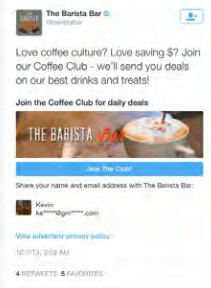
- Conversational ads, are ads that enables brands to engage directly with users, and that users can share with their followers.
These are the most popular options available, but there are others. You can find a full list of Twitter cards here; they change fairly frequently, so make sure to check in often: dev.twitter.com/cards/types
Targeting options
Twitter targeting options are nearly as detailed as Facebook. You can choose an audience based on:
- Location (country, state, region, metro area, or postal codes)
- Gender
- Language
- Device, platform, and carrier
- Keywords
- Followers
- Interests
- Tailored audiences (you can upload a list of emails or Twitter IDs, or you can put a code snipped on your website to collect visitors, purchasers, or downloaders and then target them)
- TV targeting (to target users who engage with television programs in a specific market, or by show)
- Behaviours
- Events (users interested in global or regional events).
Twitter advertising tips
- Use your own campaign, specific hashtags rather than using generic ones
- Use multiple tweets per campaign, test your options
- Include a deadline
- Monitor influencers, what works for others could work for you
- Make sure your ads contain content worth sharing.
LinkedIn ads allows you to create and place adverts on prominent pages on the LinkedIn website, including a user’s home page, search results pages, groups and more. It has both self-service and premium options, and offer ’sponsored updates’ as a self-service option. There is a minimum budget requirement of US $10 a day, though no minimum spend, that is, you have to budget at least US $10 a day, but you don’t actually have to spend any of it. Ads can be served on a CPM or CPC basis.
Objectives
LinkedIn offers 3 main objectives:
- Reach LinkedIn members in their LinkedIn feed and beyond.
- Drive targeted ads across multiple LinkedIn pages.
- Send targeted messages directly to those who matter the most to your business.
Ad types offered
LinkedIn offers five types of ad:
- Sponsored content
- Sponsored InMail (reaching your audience through their LinkedIn inbox)
- Dynamic Ads
- Display Ads
- Text ads.
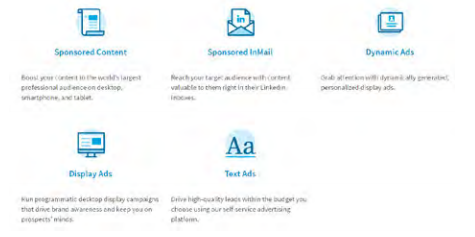
Sponsored stories are when content posted on a brand’s profile is promoted through display ads or into the feeds of users across the LinkedIn network, according to your targeting preferences. Text ads can be shown on the right-hand side across desktop, mobile, and tablet.

Targeting options
LinkedIn offers many targeting options, including:
- Job title
- Job function
- Seniority
- Industry
- Skills
- Degrees
- Geography
- Age
- Gender
- Company name
- Company size
- LinkedIn group.
LinkedIn advertising tips
- Test variations of your ads to see which is the most successful. The text ad option allows you to create up to 15 variations of a single ad.
You can find more information about LinkedIn advertising at: business.linkedin.com/.
- Consider your budget carefully. Sponsored InMail ensures you’ll at least be seen by your target, and display ads are a good way to stay top of mind, but both can be quite expensive.
- Make sure you use all the allotted characters for ad copy to describe your service.
- Use images with the correct ratio so that they look good, both on desktop and mobile.
Pinterest advertising is still relatively new and has limited availability worldwide. A business account is necessary to advertise on this platform.
Objectives
When creating a Pinterest Promoted Pin, you will be asked to choose a goal for your campaign. Your options are:
Traffic campaign: To draw users to your website
Engagement campaign: To encourage close ups, repins and clicks on your Pin
Awareness campaign: To reach a wide audience.
Ad types offered
The only ad type on Pinterest is Promoted Pin. Here, you select an already existing Pin to use. When you choose a Pin while setting up an ad, you have the option to filter your Pins to see which are your best-performing (most clicked and most repinned) Pins from the last 30 days.
Targeting options
Targeting options for Pinterest are:
- Interests and Keywords: You have 420 interests to choose from, and you can manually add keywords, import an existing list of keywords, or use the keywords that Pinterest recommends for you. Choose carefully, and try not to use all 150 keywords that the platform allows you to add, be focused.
- Specific audience: Users who have visited your site or app, engaged with Pins that link to your site, or – similar to Facebook’s ’lookalike’ audience – an ’actalike’ audience that is similar to users who are already engaging with you.
- Location
- Language
- Device
- Gender.
Pinterest advertising tips
- Make sure that the ads you select reflect your brand promise. Misleading or exaggerated claims are more than a bad idea; Pinterest prohibits them.
Read more about advertising with Pinterest at: https://ads.pinterest.com.
- Use vertical images. This isn’t required, but users prefer it.
- Optimise your pins for mobile viewing.
- Research Pinterest trends so that you can keep your campaigns relevant.
Snapchat
Snapchat’s paid advertising options are relatively young, but they have grown almost as rapidly as the app itself. There are a variety of ways that brands can advertise on Snapchat.
- Lenses and geo-filters
- Discover channels
- Live channels
- With influencers
- Takeover
- Promotion
- Unboxing
- Product placements.
Objectives
Snapchat does not require you to select an objective to create an ad, but it can help you reach the usual objectives, such as:
- Visit a mobile website
- Install an app
- Watch a long-form video
- View an article.
Ad types offered
Snapchat offers a few unusual ways to reach your audience:
- Snap Ads: Mobile video ads that can be up to ten seconds long and will be vertical and full screen. Users can swipe up and reveal extended content, which could be an article, app install, long-form video, or mobile website.

- Sponsored Geofilters: A small piece of art or writing that covers part of the snap. A business chooses a location (or more than one), and when Snapchatters in that location take a Snap, the sponsored Geofilter appears as a filter option that can help users explain the context of that snap. This is great for local targeting and can cover a specific location, event, or theme (for examples, coffee shops across Florida). Sponsored Geofilters should be fun and attractive, provide context to the Snap, and encourage users to share them.

Take a look at the first campaign to use limited-time Geofilters, where McDonald’s achieved 12 million filter snaps, 308 million filter views, and 400 million filter impressions: http:// shortyawards.com/8th/ mcdonalds-geofilters
- Sponsored Lenses: An interactive ad. The brand creates an interactive filter that can be added to a Snap, an animation can be added, and the Lens can be shared or posted to users’ own Snap Stories. They are a lot more complex to develop, and thus are a very costly and labour intensive option. Many movie franchises have found great success in raising awareness for new releases.
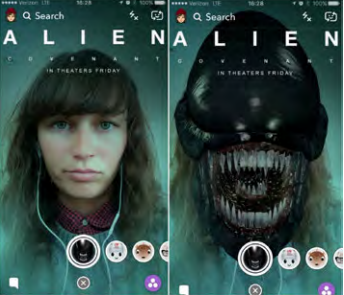
Targeting options
Snapchat includes a variety of targeting options:
- Snapchat Audience Match: Brands can anonymously match data from an existing list of email addresses and mobile device IDs to Snapchat’s consumer data. Users can opt out of being included.
- Snapchat Lifestyle Categories: Brands can target users who view certain types of videos, such as pets or cooking.
- Lookalikes: Like the Facebook option, brands can target users with characteristics similar to their existing customers.
Snapchat is also aiming to up their targeting game by enabling marketers to use data from offline purchases to target users with relevant ads.
Snapchat advertising tips
- As always, make sure your content fits the platform: Snapchat is informal and natural, using fun filters and add-ons, rather than the more posed images you might see on Instagram.
Read more about Snapchat advertising at www.snapchat.com/ads.
- Tell a story: Test your content to see what works best.
- Use influencers: This is a great way to reach even more users.
Other platforms
Of course, this is by no means an exhaustive examination of available platforms for social media advertising. For example, some marketers still like Google+, and YouTube is a huge platform for marketers. YouTube offers a wide range of advertising formats and options for businesses. These are covered in detail in the chapter on video marketing.
Read more about this in the Video marketing chapter
Different countries have different preferred platforms. For example, Weibo and WeChat are very big in China. Check out a case study focusing on Russian audiences here: www.digitaltrainingacademy.com/casestudies/2017/01/social_media_case_ study_asos_reaches_russian_audience_through_vk_and_yandex.php#more
Make sure you do your research so that you know which platforms your audience is active on and where you might want to advertise. For example, Reddit (www. reddit.com), along with similar content curation platforms, is great for sharing good content, but the community is very advertising-savvy and does not welcome overt ads that do not provide value to the user.
You may also want to keep an eye on up-and-coming platforms, such as Wanelo (wanelo.com).


